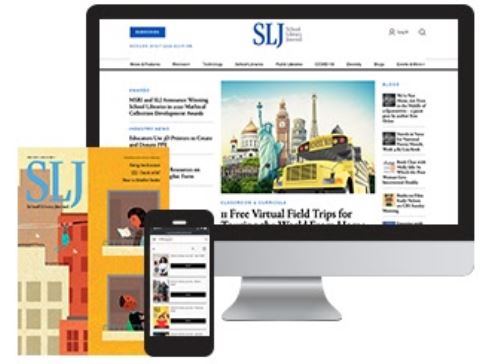Basketball Coach Scores at the Library | Reasons to Love Libraries
When Coach Feiler signed on to work as our high school library teaching assistant, he transformed the programming and the vibe.
 |
Catherine Masrour and Jonathan Feiler (center, left and right) with students |
Our library at Smithtown (NY) High School West, on the north shore of Long Island, serves around 1,200 students. This year, our district decided to hire teacher assistants (TAs) to help in the library. After receiving few applications from librarians, we expanded to include TAs with other backgrounds. I reasoned that the high school library could benefit from someone with STEM or maybe Spanish language expertise.
But our best candidate was our assistant basketball coach, Jonathan Feiler—a former college and international pro basketball player. Jonathan was a quick learner about all things library, and I was about to learn an important lesson from him and his team that would change how I think about what we do.
As soon as Mr. Feiler—“Feiler” to the kids—started his new job, the boys’ basketball team took up residence in the library. Other student athletes began spending more time there, too, suddenly curious about what goes on. Previously, I had tried to catch the attention of these students during orientations and other library visits, but, despite showing all the books, 3-D printers, board games, and LEGO, few seemed interested.
But Feiler drew a crowd. The students came in chanting “mak-er-space, mak-er-space, mak-er-space!” which became the intro to our Makerspace Podcast. During our LEGO challenge month, Feiler brought in more than 100 students. Joe Devito, a football and basketball player, was one of the most creative LEGO designers. It seemed like any form of competition, on the field or in the makerspace, was the key to creative success for Joe and many other students.
[Also read: "Librarian Brings Greenhouse, Sustainable Practices to School | Reasons to Love Libraries"]
When LEGO month ended, the students insisted we keep it going. We made brackets for playoff matches. Winners faced off against one another. Now our makerspace is used every period by many students, and athletes have partnered with other kids and formed new friendships. During LEGO competition season, even on senior cut days, students would come to the library to make sure they didn’t miss a competition day. Our space became a home to them, and to Jonathan. In addition to his work as a coach and in our library, he is now enrolled in the LIS program at SUNY Albany and is studying to be a school librarian.
As my library transformed, I realized that with all my own degrees and textbook learning, I hadn’t had what it takes to make it welcoming for many athletes. Now athletes were using the library multiple times each day.
Active learners can struggle within the confines of our traditional education system. The industrial model of sitting kids in rows, lecturing, and—at the bell—sending them to the next class to sit and listen was at the heart of their disengagement in school. Some athletes articulated that the library makerspace experience is different and a relief from their classroom structure. It isn’t that these students are not great learners or are disinterested, but many are active learners responding to the crushing effects of sitting and listening period after period.
And while teachers have complained to me about students using phones in class, I haven’t had a single instance of kids being glued to their phones. By allowing them to follow their curiosity and participate in active learning, I have seen incredible creativity, teamwork, communication, and problem-solving—essential skills for work and life in the 21st century.
High school is heavy these days. Let the library be a place where everyone can thrive, including active learners exploring and expanding their creativity. You’ll build their trust and respect—and they will remember the library as a place to come for support on whatever interests them. And you may just find a new library chant along the way.
Here are some tips for building your own library team.
Be a coach
Guide from the side. If you have your heart set on a March Madness book bracket but your students demand LEGO activities… listen to them. Many skills can be developed with a LEGO competition. LEGO free builds require top-level creativity, and LEGO kit builds call on skills such as following directions, reading manuals, spatial thinking, and interpreting visual images. Our students raised funds to buy the Avengers Tower, a $500 LEGO set. They figured out how much it would cost and how they could raise the money, and they succeeded. Then we figured out how long it would take 20 students to build the tower. We featured it on our podcast and invited LEGO key account manager Joseph Sanfilippo to visit the day we completed the project. Most people won’t make LEGO for a living, but these students will know how to set a goal and achieve it.
Build your team
Attend sports and other school events, ask questions, and show interest. I learned more from watching one of our outstanding basketball players for three minutes than I did in any course on student achievement and motivation. Incredible multitasking occurred each time he brought the ball down the court. He dribbled with his right hand while looking up, called the new play with his left hand, watched teammates to see who was open, all the time defending the ball from the other team and looking for an opportunity to score. His skill on the court translated to success in the library. He was a lead LEGO competitor and consistently brought creative ideas to the forefront. I am sure he will remember the library as a place where he is welcome and can explore his interests.
Provide plenty of play time
Everyone wants play time. Find out what interests your students and provide them with the resources. One student athlete wanted to do a makerspace podcast, so we used our equipment and helped him make it happen. He has recorded more than 50 podcasts this year. Another asked for Perler Beads. I thought that these might not be a great investment for the makerspace or the environment, but I bought them. Joe has re-created a van Gogh artwork, The Great Gatsby book cover, a giant colorful parrot, and multiple other designs. Many students are interested in creating with Perler Beads now.
Catherine Masrour is a library media specialist and instructional specialist in the Smithtown (NY) School District.
RELATED
The job outlook in 2030: Librarians will be in demand
The job outlook in 2030: Librarians will be in demand
ALREADY A SUBSCRIBER? LOG IN
We are currently offering this content for free. Sign up now to activate your personal profile, where you can save articles for future viewing






Add Comment :-
Be the first reader to comment.
Comment Policy:
Comment should not be empty !!!